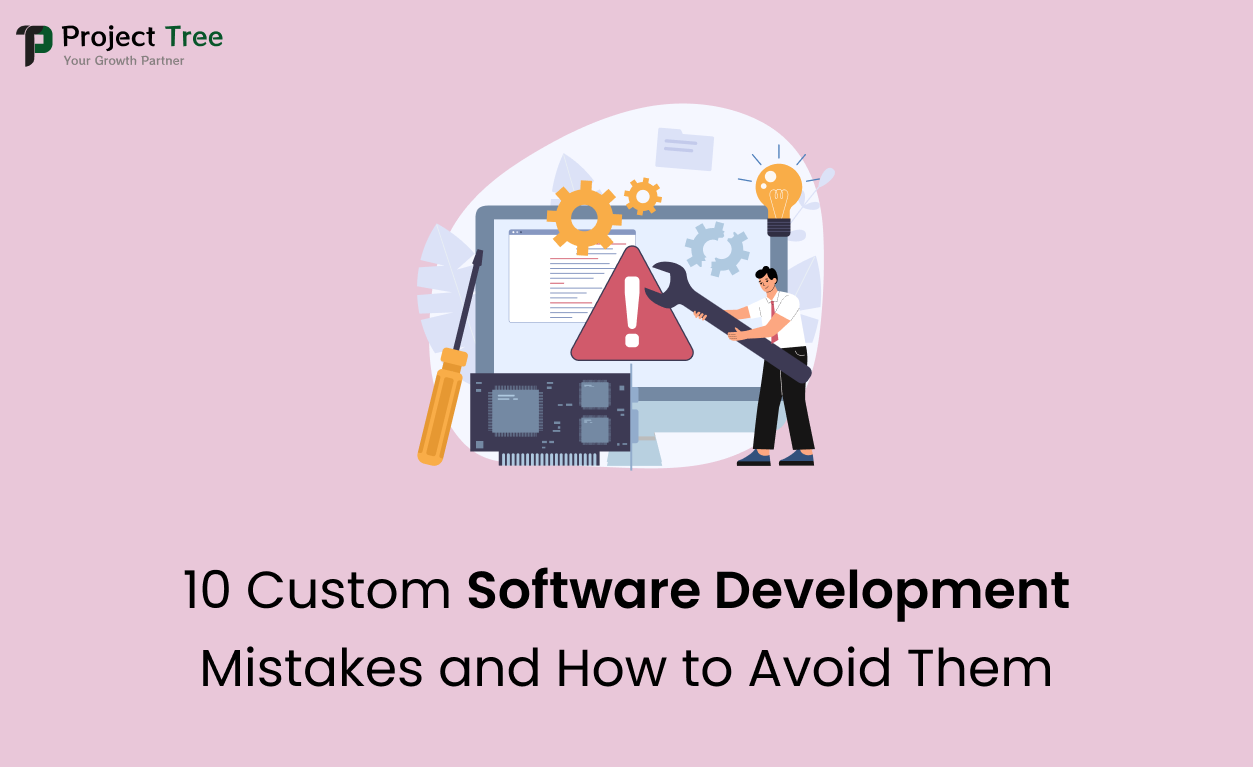Custom software development has become an essential part of present-day company operations. As organizations try to enhance efficiency by offering specific solutions, the need for customized software has grown. Yet, the process of developing custom software development is fraught with risks that may result in lost time, effort, and money. Knowing these usual pitfalls is essential for companies trying to launch an effective software creation project. In this article, i take a look at 10 common in custom software development and provide specific recommendations for avoiding them.
1. Lack of Clear Requirements
The failure to specify precise and thorough requirements is one of the most significant mistakes made in the creation of custom software. Often, users presume that programmers know their demands without explicitly outlining them. The absence of openness can result in confusion, scope creep, and an item that fails to meet objectives.
How to Avoid It:
It is essential that you carry out complete requirement-gathering sessions with every stakeholder in order to avoid this error. Utilize tools like surveys, interviews, and workshops for gathering particular data. In addition, creating a requirements document describing key functionality, interfaces for users, and system interactions can be used as a guide throughout the creation process.
2. Ignoring User Experience (UX)
Understanding the important issue of user experience (UX) is a typical error. A product can be working, yet if users struggle to navigate or understand it, they are likely to make use of it. Bad experiences can lead to consumer dissatisfaction and a high withdrawal rate.
How to Avoid It:
Apply UX design concepts from the project’s beginning. Involve UX designers in the development process and carry out testing for usability with actual customers. Such feedback may help identify problems and opportunities for development, making sure the result is accessible and meets customer demands.
3. Underestimating Time and Budget
Unrealistic time and cost forecasts affect numerous projects. Participants’ visions can exceed their initial estimates, leading to delay and overspending. This underestimate is typically caused by a lack of understanding of the complexity of software development.
How to Avoid It:
Make use of agile techniques that allow rapid creation along with periodic revisions to budgets and timelines. Employ skilled project managers who may offer more accurate estimations because of their experience with projects that are comparable. Evaluate and alter schedules and budgets if necessary throughout the project.
4. Poor Communication
To create technology successfully, efficient interaction is important. Incorrect communication among employees, stakeholders, and clients may result in mistakes and confusion that harm the project.
How to Avoid It:
Create specific paths and processes to interact right away. Employ management of projects technologies to encourage cooperation while keeping everyone updated. Regular conferences and reports can help keep everybody on the exact same page while tackling any problems as quickly as feasible.
5. Overcomplicating Solutions
Some developers might try for imagination at the cost of too complex, scalable, and sustainable systems. Although it is essential to create an effective application, too much detail could hinder potential extensions and raise expenses.
How to Avoid It:
Remember to keep everything easy and logical. Push programmers to pick simple solutions that fit the criteria effectively. Perform frequent code audits in order to maintain the source code neat and feasible.
6. Neglecting Testing

Testing is an essential element of the creation of software and must never be missed. Many organizations abandon lengthy testing handles to save a period of time, leading to undetected weaknesses and problems in the final item.
How to Avoid It:
Make use of unit, integrating, and user acceptance tests (UAT) as a component of a thorough testing approach. Promote an environment of quality assurance (QA), in which testing is incorporated into the creation process instead of being viewed as a separate stage. Conduct tests frequently during the creation cycle to detect and fix errors as quickly as possible.
7. Ignoring Security
Considering increasing cybersecurity risks, skipping security during the creation process could prove deadly. A breach of security may result in loss of information, legal issues, and damage to reputation.
How to Avoid It:
Embrace best practices in developing software and make safety the primary concern immediately. It involves conducting common security audits, adopting safe programming methods, and integrating testing for safety into the creation process. In addition, keeping current on the latest safety developments and attacks may help minimize risk.
8. Failing to Plan for Maintenance
A lot of organizations neglect the importance of setting up for software maintenance following deployment. A successful launch is just the start; with regular upkeep, software may grow outdated and ineffective over time.
How to Avoid It:
The initial development strategy ought to incorporate a schedule for upkeep. The strategy ought to outline when updates, corrections for bugs, and customer support will be managed after the application goes public. Having a dedicated support group or source can help maintain the software employed and current.
9. Not Considering Scalability
A significant error in custom software development is not to take into account scaling. As companies grow, their software needs could shift, and a lack of flexibility could hinder future development.
How to Avoid It:
Scalability should be studied when developing software. It could include choosing technology that can easily support expansion or ensure that the structure can handle increasing demand. Scaling testing is carried out to assess the way the application operates at various load scales.
10. Not Choosing the Right Development Partner
The success of an outsourcing custom software development project may also be significantly affected by selecting the wrong development partners. A shortage of ability, difficulties with communication, or mismatched goals can all result in poor outcomes.
How to Avoid It:
When selecting a development companion, look for a team with a track record and appropriate expertise. Check their resumes and customer reviews to assess their level of expertise. Partnering with an established company, like Projecttree, will give you the expertise needed to effectively navigate the complicated world of custom software development.
Conclusion
If you want a successful project, it is essential that you stay away from the usual dangers in custom software development. Companies that comprehend and handle these issues may save cash and time and ultimately create an item that fulfills consumers. Open dialogue, user-centered layout, and a focus on security and maintenance are every requirement of an effective creation process. Companies that properly organize and carry out their software projects are more likely to benefit from solutions that are suited to their specific needs.
ProjectTree and DrPro partnership brings a new level of synergy, combining advanced project management tools with innovative healthcare solutions.
FAQs
Q1. What is the most common mistake in custom software development?
The first is a decision that is possibly made most frequently—the absence of clear, tangible requirements. This is a key problem because without proper specification on what the software is supposed to do, faulty work is done and the product developed does not meet the business requirements, resulting in more expenses on correction.
Q2. How can I ensure my software development project stays on budget?
Budget control begins with estimates of costs and coherent, flexible approaches to work. Ensure that there are mapped timelines and costs, which should be continually assessed throughout the development of the project.
Q3. Why is user experience important in software development?
User experience management makes sure that the user of the software is satisfied and that they can use it with a lot of ease. A good UX would result in better user satisfaction and engagement, as well as an increased overall success of the given product.
Q4. How do I make sure my software is scalable?
The decision on what level the software is to scale should be made prior to the commencement of the endeavor. First, make sure that the software design and chosen technological platforms will be able to grow further and adapt to the new needs of your target audience.
Q5. Why is testing crucial in software development?
It involves carrying out a trial run of software to see whether it has defects or whether there will be any in the future after release. Testing makes the product better and less expensive in the long run and helps to ensure that the software is functional and security adequate.

